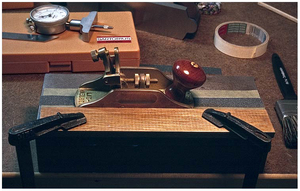grooves n'stuff (page 2)
So it's worth thinking about modifying planes that are intended for bamboo use only and putting a groove into the soles, e.g. if you plan to build a big, two-handed rod for salmon or steelhead fishing some time in the future and you are unwilling to spend mucho dinero buying a custom made form for just a few rods you will probably make for yourself or friends using that specialty form.
As already mentioned, the main problem I encountered was to put in the groove without using any machinery. It is most important to produce a groove of uniform depth. At the first glance this seems to be simple, at the second glance a daunting task, but in the end it is in fact amazingly simple to do.
